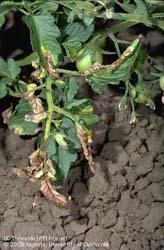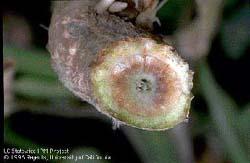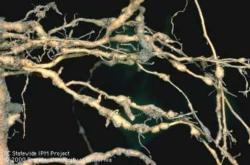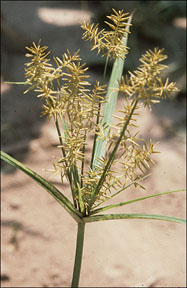
June
Tomato
Blossom Drop
Q. Why are my tomato blossoms falling off the plant?
A. Tomato blossoms will drop off when temperatures fluctuate below or above the required temperature zone for any extended period of time. In order to hold blossoms and set fruit, tomatoes need night temps above 55 degrees and daytime temps below 90 degrees. Blossoms will also dry up and fall off if plants do not receive enough water, if they're getting excessive nitrogen and receive too much shade. Regularly monitor soil moisture levels, especially during hot spells. The top inch or two of soil can be allowed to dry out, but consistent moisture should always be available to the roots.
Verticillium and Fusarium Wilt
Q. Why are the leaves on my tomato plants turning yellow at the tips, wilting, becoming brown and dropping off?

Wilt resistant seeds and plants of most tomato varieties are available. Look for the letters V and F next to the varietal name. V indicates verticillium resistant, F indicates fusrarium resistant.
Pest Notes: Verticillium wilt Fusarium wilt

Blossom End Rot
Q. The bottom (the bottom end) of my tomatoes is brownish-black and looks kind of rotten. What is causing this and can I still eat the rest of the tomato?
A. Blossom end rot is not caused by microorganisms. It is a disease involving calcium nutrition and water balance in the plant. Tomatoes are heavy feeders. Make sure to add extra calcium (such as bone meal) when planting and use a balanced plant food containing calcium through the growing season. Maintain even soil moisture. And, yes, the rest of the tomato is edible.
Pest Note: Blossom End Rot
Spindly Plants
Q. My tomato plants just don't seem to be growing much and some are browning from the bottom up. And what growth they do have looks sort of sickly. What is causing this?

The old-wive's tail that marigolds will repel nematodes may have some truth to it. Recent studies have shown that "green-tilling" in large amounts of French marigolds (Tagetes patula) in the fall after harvest can reduce nematode populations in the soil for a short time. Planting or tilling in other varieties of marigolds had less or no effect. Soil solarization is a better method to help reduce the population as is crop rotation. The best solution is to plant resistant tomato varieties with the letter N after the name.
Curling Leaves
Q. At first, only a couple of my tomato plants had curling leaves, now they all do. What is causing this, is it serious and how do I fix it?
A. Infestations of both whiteflies and aphids will cause curling leaves. Check the underside of the leaves for small white insects (whiteflies) or small green or brown insects (aphids). If a cloud of tiny, white insects flies up when you tap the plant, they're whiteflies for sure. A host of beneficial insects feed on aphids and whiteflies, including green lacewings and lady beetles, and they can control the bad bug population nicely, so try non-toxic control methods first. Periodic strong blasts of water from the hose will knock off aphids and yellow stricky traps attract whiteflies. Use insecticidal soap if populations are becoming too large and use chemical pesticides only as a last resort.
Pest Notes: Whiteflies Aphids
Nutgrass
Q. A weed that looks like grass, but has triangular blades and round (tuberous) roots is everywhere in my yard. What is it and how do I get rid of it? 
A. The description matches that of nutsedge or nutgrass, a very hard-to-eradicate weed. Nutgrass grows and reproduces from both seed and tubers. The best control is to pull up nutgrass as soon as it appears when it has less than 5-6 blades and before the tubers are well-developed. When trying to pull out mature nutgrass, the blades will break off leaving the tubers in the soil to sprout again. Small localized spot treatments with a translocating herbicide (such as glyphosate) may need to be repeated several times and control is not guaranteed. Treatment postemergent with bentazone, MSMA or halosulfuron can bring control with several applications. Nutgrass thrives in soggy soil and the tubers are drought-tolerant (ain't nature swell?). Irrigate properly, mow high to elimiate seed heads and do not till nutgrass-it just spread those tubers around and they can survive for 4 years in dry soil.
Pest Note: Nutsedge
Budworms (especially in petunias)
Q. My petunias (and many other plants) have small round holes in the leaves and no flowers-the buds are empty. Why?
A. Over 100 varieties of moths lay eggs that will produce small caterpillars or budworms that feed on leaves, buds and flowers. Many caterpillars are killed by viruses and diseases and by beneficial insects, such as parasitic wasps. The best bacterial control for all caterpillars (including tomato hornworm) is Bacillus thuringensis (Bt), a bacteria which destroys the digestive system of caterpillars and many other insect larvae and which is not toxic to any other life forms. Bt, as it is called, is available at all good garden centers and nurseries. It usually comes in powder form that is mixed with water. It's a good idea to keep a very small bath mixed up and ready to spray at the first sign of damage-repeated every 3-4 days. The effectiveness of Bt is reduced by exposure to sunlight, so spray late in the day, if possible.
Pest Note: Foliage Feeding Caterpillars
